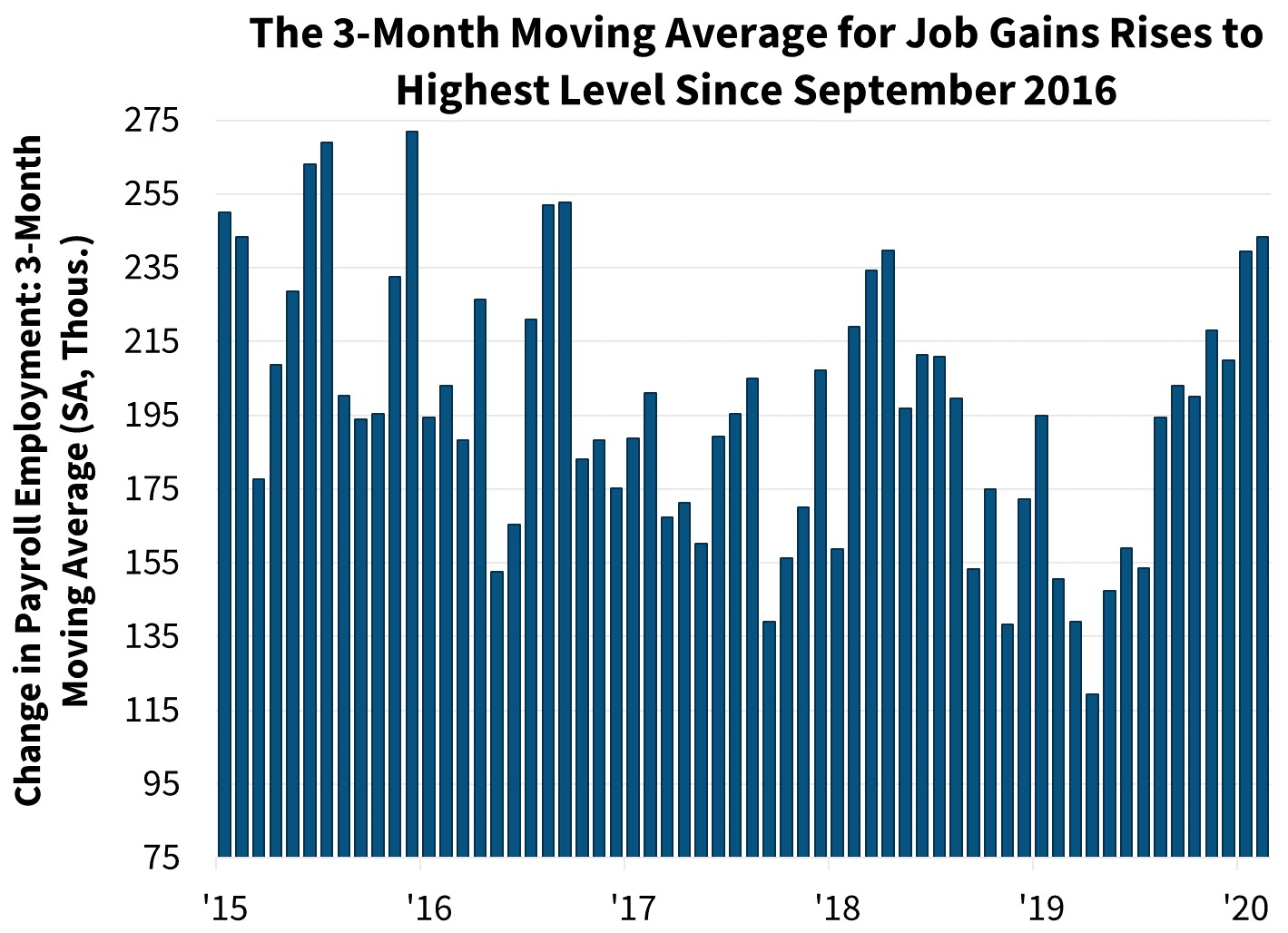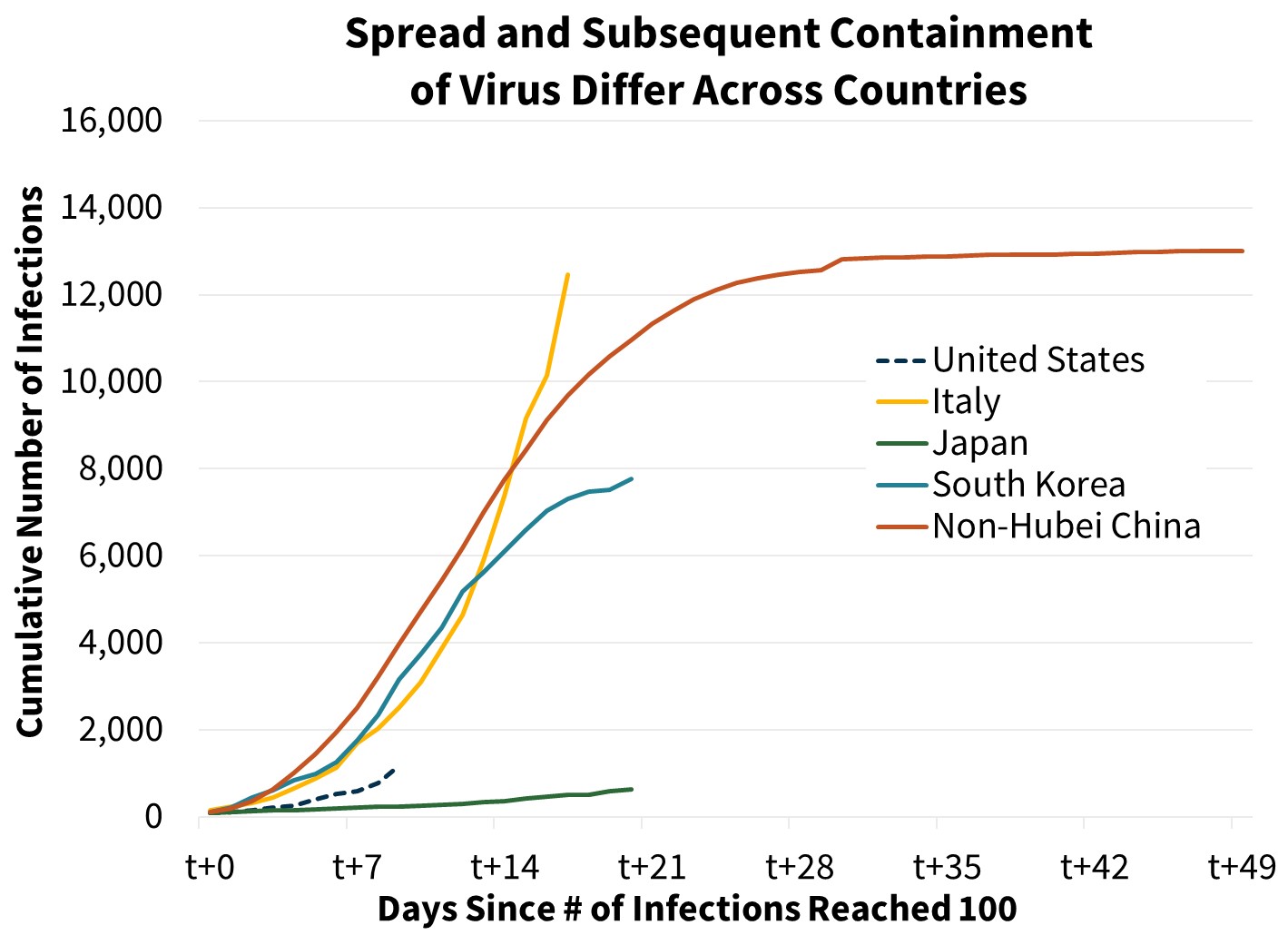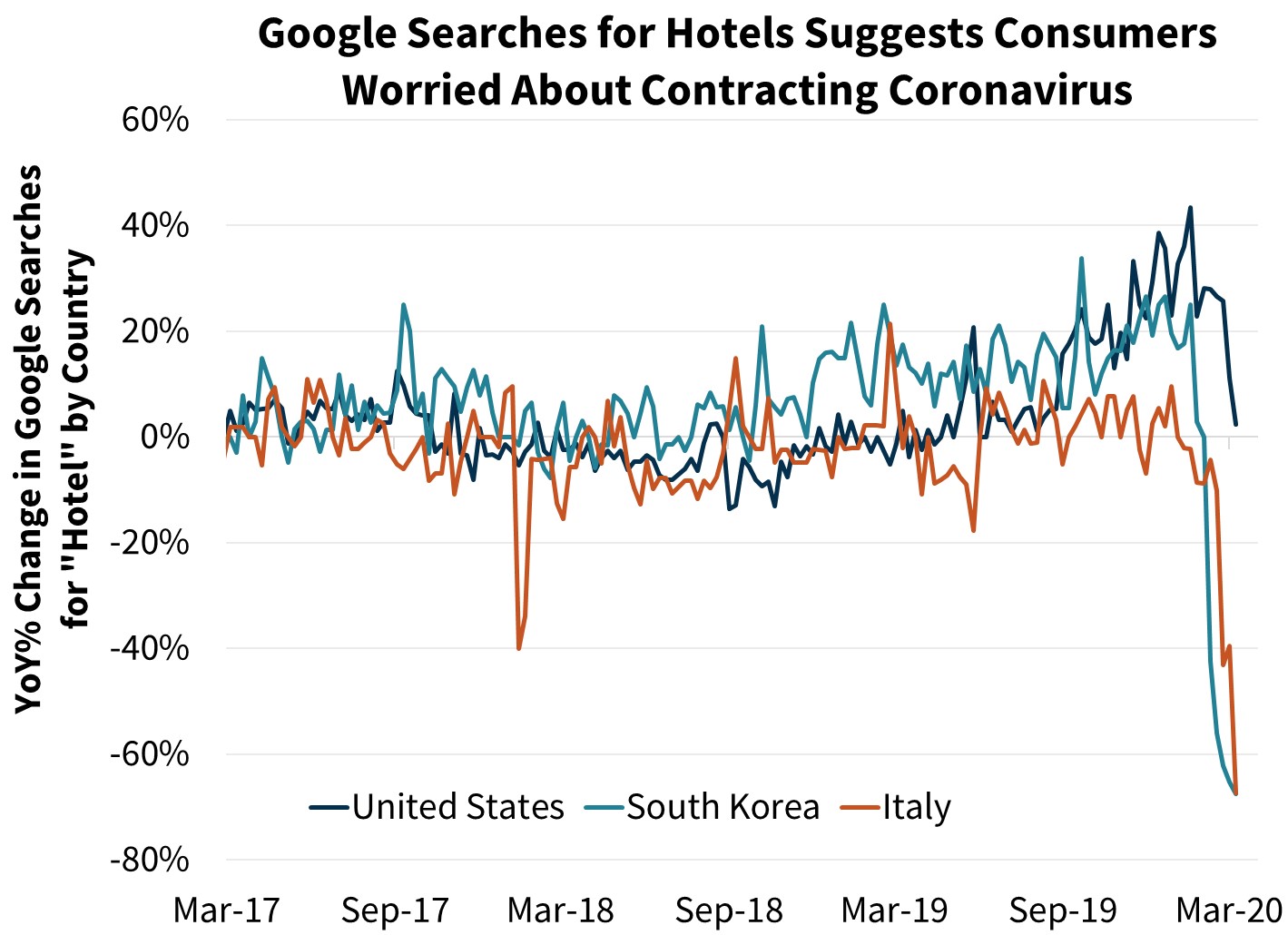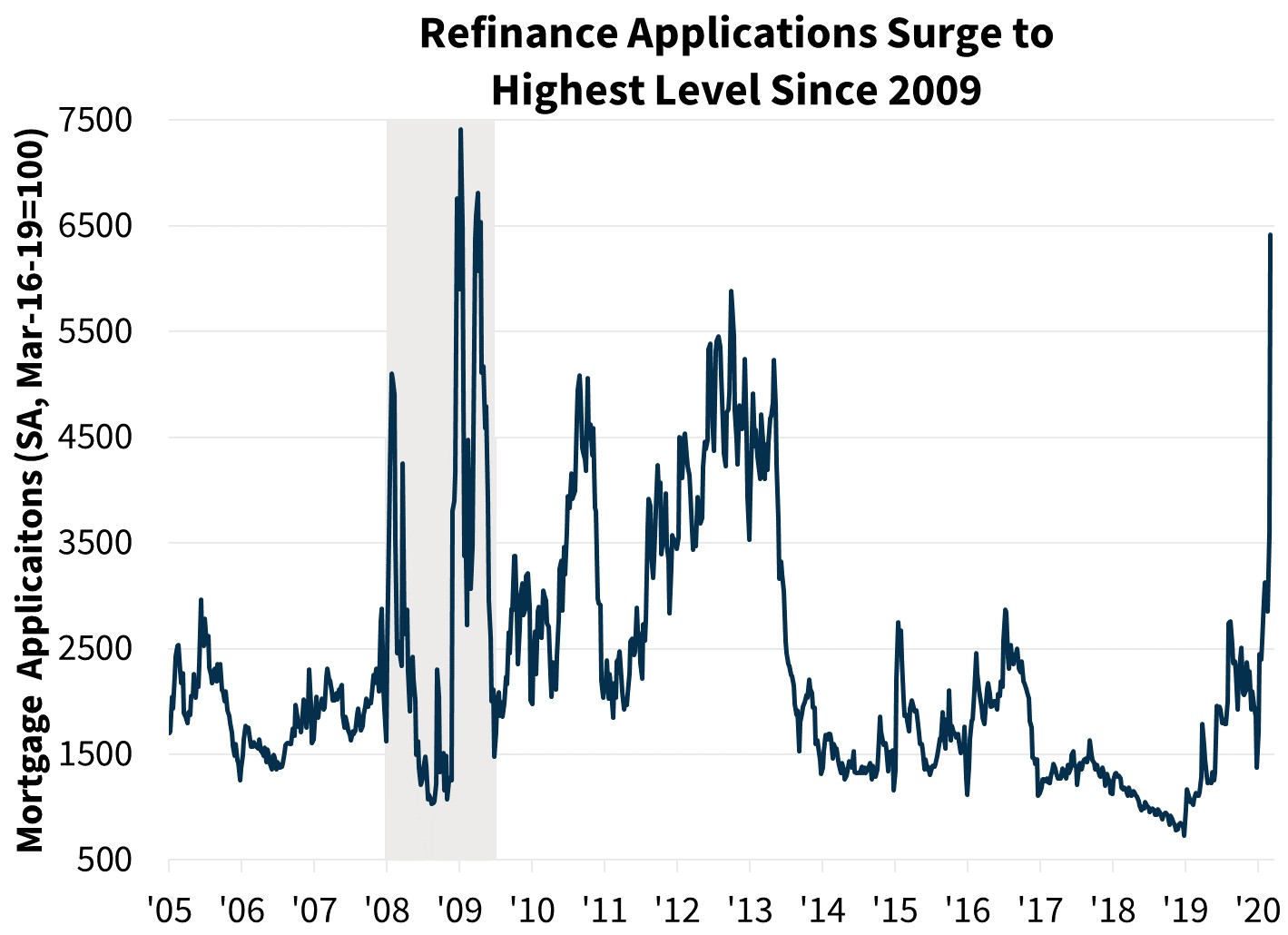Economic Resilience Tested by COVID-19 and Oil Prices
We have revised downward our 2020 growth forecast to 1.8 percent from last month's 2.2 percent. Primary causes are the COVID-19 (coronavirus) spreading beyond mainland China, Saudi Arabia's decision to dramatically increase oil production, and the resulting impacts on financial market volatility and consumer behavior.
In the first quarter, we expect these developments to shave about three-tenths of one percent from real gross domestic product (GDP) growth. However, due to updated data and an increase in our short-run forecast for residential fixed investment, on net we revised first quarter growth down by only one-tenth to 1.8 percent. For the second quarter, we now forecast near-zero growth, as we expect meaningful softness in consumer spending and business investment stemming from financial market volatility, lower oil prices, and behavioral changes related to infection avoidance. We forecast a rebound over the second half of the year, partially making up for weaker growth in the first half of 2020.
A potential decline in future consumer sentiment may soften demand for "big ticket" items, including home purchases, while sales listings may be held back by sellers worried about contagion or short-term declines in potential buyers. However, mortgage rates falling in early March to a historic low should provide counterweight for housing demand. We believe home sales and construction are therefore likely to fare comparatively well in coming months, even as growth slows. Combined with better-than-expected housing data to start the year, we revised modestly upward our forecast for 2020 total home sales growth to 2.9 percent from 2.3 percent. We also increased our forecast for 2020 mortgage originations to $2.6 trillion, largely driven by stronger refinancing, up from a previous forecast of $2.3 trillion.
Heightened risks to the outlook are driven by uncertainty over the extent and duration of the coronavirus outbreak, how greatly consumers and firms will respond to avoid infection, and what government policies will be implemented. Little historical precedent exists to aid in assessing the economic impact, and a wide range of outcomes could plausibly occur. Our baseline forecast assumes that the global outbreak will begin to recede by mid-2020, with economic activity beginning to rebound in the summer. Risks to our forecast are therefore weighted significantly to the downside. While there is upside potential that the outbreak is short-lived, if it spreads well beyond its current scope – or if economic behavior is depressed for considerably longer than expected – a global recession is possible.

The First Quarter Started Off on Solid Footing
While real personal consumption was weaker in January than expected, rising only 0.1 percent, real personal income jumped 0.5 percent, providing support for solid consumer spending going forward. The February employment report also painted a bright story, with 273,000 jobs being added for the second consecutive month, a figure above consensus expectations. Furthermore, on net, past months were revised upward and the unemployment rate ticked down to tie the expansion low of 3.5 percent. The February reading of the University of Michigan Consumer Sentiment Survey also showed little sign of worry regarding the coronavirus, as it rose 1.2 points to 101.0, just shy of the expansion high reached in March 2018.
The long-awaited recovery in manufacturing and business investment following a de-escalation in the U.S.-China trade conflict also seemed to finally be approaching. Shipments of core capital goods, a proxy for business investment, rose 1.0 percent in January after falling for the prior two months, the largest gain in a year. Additionally, despite ongoing issues related to Boeing, the February reading of the ISM manufacturing survey came in at 50.1, the second consecutive reading above the expansionary threshold of 50. This followed five months of contractionary values.
Coronavirus Elevates Forecast Uncertainty
While the year started off with solid economic growth, it has likely slowed since the spread of the coronavirus. Assessing the full impact of this development remains a challenge. Most recent economic data predate the outbreak moving meaningfully beyond mainland China, and at a global level, the extent to which individuals and government policies have responded is unprecedented in modern history. Therefore, in thinking about its impacts, it is useful to consider multiple possible scenarios:


1. Short-Run Outbreak Mostly Overseas: It is possible with further isolation measures and warmer weather approaching in the northern hemisphere that the outbreak will soon peak. As of this writing, cases in China and South Korea appear to be leveling off, and Chinese economic output is recovering, though slowly. In this case, U.S. growth would be negatively affected mostly through international trade and tourism channels, and financial market volatility leading to weaker consumer and business confidence. This scenario can be thought of as being like past periods of financial market volatility, likely resulting in only a modest softening of growth. This scenario represents the upside case to our baseline forecast described below.
2. Short-Run Outbreak Including the U.S.: Even if the outbreak lasts only two to three more months, a significant slowing of growth would be probable in the second quarter (perhaps even contraction). The comparatively greater economic impact in this scenario is due to behavioral changes aimed at infection avoidance that likely result, for example, in a decline in spending on food service, entertainment, hospitality, and domestic travel. This behavior is widely occurring in South Korea and Italy, and appears to have now reached the U.S. with a growing list of event and flight cancellations. In addition to these demand-side factors, school and workplace closings could reduce output. We believe this slowdown in growth would likely still be followed by a rebound, but the hit to full-year growth would be larger than in Scenario 1. A mild version of this scenario is assumed in our baseline forecast. The extent to which second quarter growth is affected depends on the scope of domestic infection, avoidance behavior aggressiveness, and government policies implemented in response.
3. Longer-Run, Severe Global Outbreak: The World Health Organization made a formal announcement on March 11 declaring the coronavirus a pandemic. If the outbreak becomes broader and long-lasting – similar to severe, historic influenza pandemics that infected 10 to 40 percent of the global population over 12 to 18 months – significant job losses and firm closures resulting in a global recession becomes more likely. A high percentage of workers out sick and meaningful numbers of fatalities would directly harm economic output. We do not believe this scenario is the most probable outcome at this point, but the downside risk should be considered.
Fed Makes an Emergency Cut – Fiscal Policy to Come?
The Federal Open Market Committee (FOMC) cut the federal funds rate by 50 basis points to a range of 1.00 percent to 1.25 percent at an emergency meeting held on March 3, citing that "The fundamentals of the U.S. economy remain strong. However, the coronavirus poses evolving risks to economic activity." The FOMC will meet for its regularly scheduled meeting on March 18, and we are expecting an additional 50 basis point cut then to a range of 0.50 percent to 0.75 percent. We also forecast that, as financial volatility and uncertainty surrounding the coronavirus fade, the Fed will reverse these cuts and raise rates by 50 basis points early next year. In addition to this accommodative monetary policy, expansionary fiscal policy may be on the table, as federal proposals regarding payroll tax cuts and sick-leave subsidies for hourly workers are beginning to circulate.
Lower Mortgage Rates Will Likely Support Housing Amid High Level of Uncertainty
January housing data came in somewhat stronger than expected, especially new single-family sales and housing starts, likely due in part to unseasonably warm weather. Combined with upward historical revisions, housing activity is poised for strong growth this year if it can remain resilient in the face of the coronavirus.
Sales in coming months are likely to face competing short-term forces. On one hand, the steep drop in mortgage rates due to financial market turbulence strengthens housing demand and boosts buyer purchasing power and affordability. At the same time, few homeowners will be experiencing a "lock in" effect from having a current mortgage with a lower rate than is currently available. This will potentially lead to more move-up buyers and greater for-sale inventories of starter homes.
On the other hand, consumer sentiment is likely to be dampened due to financial turbulence and slowing economic growth. Furthermore, some potential buyers and sellers may be hesitant to tour or list their homes, respectively, due to fear of coronavirus contagion. Alternatively, they may not list their property because they feel that demand will temporarily be dampened. With regards to new home construction, it is possible that supply chain disruptions will limit housing completions. The magnitude of these effects will be determined by the extent of the outbreak and how severely economic growth slows.
Which set of effects end up being dominant will change depending on the outbreak scenarios. In the upside and baseline cases, we believe the negative interest rate shock would be the stronger driver, boosting home sales. Therefore, we increased our forecast for existing sales over the first half of the year, but by a lower magnitude than if the decline in interest rates was independent from the coronavirus. The more severe scenario would increase the likelihood of slowing housing activity due to prolonged economic slowdown and its repercussions for labor markets.
At least through February, consumer sentiment appears to have held strong. The Fannie Mae Home Purchase Sentiment Index®, while declining slightly in February by 0.5 point to 92.5, remained near a historic high. Similarly, the Northwest Multiple Listing Service showed that Seattle-area housing activity remained brisk in February despite it being the most heavily impacted region in the U.S. by the coronavirus to date. According to the press release, "it was too early to tell" if buyers or sellers were holding back due to contagion fears. Redfin also acknowledged that it was early but announced that some of their agents in the Seattle region were reporting cancelled listings in the first week of March with home sellers citing the coronavirus.
Underneath these short-run dynamics, a lack of homes available for sale continues to limit the potential sales pace. The months' supply of existing homes sat at only 3.1 in January, a record low for that month. For the year, we expect only modest existing sales growth of 2.0 percent to 5.45 million units. The lack of existing homes for sale, however, continues to support new construction. While single-family starts fell 5.9 percent in January, it followed a surge in December to an expansion high of 1.07 million annualized units. Both months were likely supported by unseasonably warm weather, and some continued pullback is expected in the short run, but the pace of new construction was strong to begin the year. Single-family permits, which tend to be less volatile than starts, rose 6.4 percent in January to the highest level since 2007. Furthermore, after being elevated for much of last year, the supply of new homes for sale at the current sales pace fell to 5.1 months, back to well within the historical range. If new sales growth is to continue, a faster pace of construction will be necessary. Due to limited already-started homes relative to the sales pace, we expect new sales growth to pause on average for the next few months as the pace of construction catches up.
Multifamily housing starts, following a 25.4 percent surge in December, inched up another 0.7 percent in January to 557,000 annualized units, the highest level since 1986. While continued strength in multifamily construction is evident, the starts pace in these two months greatly exceeded the usual relationship to multifamily permits, thus we are expecting a meaningful pullback in the near term. For the year, we forecast multifamily housing starts to reach 416,000 units, the largest annual level in over three decades.
With regards to the coronavirus, the multifamily sector is not to be severely impacted under the base and upside risk scenarios. Impacts to materials shipping will be largely inconsequential to 2-3-year multifamily project timelines and downward pressure on interest rates has created an even more favorable lending environment. In the downside risk scenario, however, declines in U.S. employment levels would clearly dampen rental household formation and demand leading to higher vacancy rates and declining rent growth.
For more on multifamily market conditions please see the March 2020 Multifamily Market Commentary.

Refinance Boom Expected to Continue
The average 30-year fixed mortgage rate fell 15 basis points in February to 3.47 percent, according to Freddie Mac. The rate fell further in the week of March 6 to 3.29 percent, the lowest in survey history. The steep drop in mortgage rates mirrors a sharp decline in the 10-year Treasury rate driven by a global flight to safety. Lower rates have driven a surge in mortgage refinancing. After increasing around 30 percent in both January and February, refinance applications surged a further 78.6 percent in the first week of March to the highest level since 2009.
The Q1 2020 Fannie Mae Mortgage Lender Sentiment Survey® reported that lenders' expectations of consumer demand for purchase and refinance mortgages hit survey highs, with many pointing to favorable interest rates as the engine driving the demand. With rates falling further since the mid-February data collection period, we expect continued strong origination volumes and strong lender profitability.
As of this writing, mortgage rates have fallen over 40 basis points since the start of the year, but further declines may continue, even if the 10-year Treasury yield stabilizes. In part due to lender capacity constraints and interest rate volatility, the spread between the 10-year Treasury and the 30-year mortgage rate is now about 2.3 percent, while the average spread in the second half of 2019 was around 1.9 percent. We expect the spread to remain higher than what is typical in coming months, as past experiences in 2012 and 2016 suggests that mortgage spreads would take a few months to become compressed. However, one implication is that even if Treasury rates start moving meaningfully upward when financial market volatility subsides, there is room for mortgage rates to remain near current levels as lender capacity constraints ease and the spread narrows.
We have revised upward our forecast for total mortgage originations in 2020 from $2.28 trillion to $2.58 trillion. Our forecast for refinance originations increased sharply from $895 billion to $1.17 trillion, while our purchase originations forecast increased more modestly to $1.40 trillion. We expect the refinance share in 2020 will rise to 45 percent, the highest share in four years.
Economic & Strategic Research (ESR) Group
March 12, 2020
For a snapshot of macroeconomic and housing data between the monthly forecasts, please read ESR's Economic and Housing Weekly Notes.
Data source for charts: Google Trends, Johns Hopkins CSSE, Mortgage Bankers Association, Bureau of Labor Statistics, Fannie Mae ESR Group.
Opinions, analyses, estimates, forecasts and other views of Fannie Mae's Economic & Strategic Research (ESR) Group included in these materials should not be construed as indicating Fannie Mae's business prospects or expected results, are based on a number of assumptions, and are subject to change without notice. How this information affects Fannie Mae will depend on many factors. Although the ESR group bases its opinions, analyses, estimates, forecasts and other views on information it considers reliable, it does not guarantee that the information provided in these materials is accurate, current or suitable for any particular purpose. Changes in the assumptions or the information underlying these views could produce materially different results. The analyses, opinions, estimates, forecasts and other views published by the ESR group represent the views of that group as of the date indicated and do not necessarily represent the views of Fannie Mae or its management.
ESR Macroeconomic Forecast Team
- Doug Duncan, SVP and Chief Economist
- Eric Brescia, Economist
- Rebecca Meeker, Financial Economist
- Mark Palim, VP and Deputy Chief Economist
- Nick Embrey, Economist
- Richard Goyette, Business Analyst
